A Riverboat’s Paddlewheel
Oceangoing ships would opt for screw propulsion earlier than their riverboat counterparts. While constant contact with the water was beneficial in rough ocean conditions, it posed a detriment in early river travel. The wear and tear on screws were harsher in clogged and snag-prone conditions. Major damage could incapacitate a packet boat, and it was much easier for a riverboat’s carpenter to make repairs to a vessel’s above-water paddlewheel rather than a submerged screw prop.
A paddlewheel also allowed riverboats to ride at a shoal draft which permitted navigation among the shallow western tributaries. This helped extend the packet’s reach further inland. While future engineering would deepen and clean rivers, those early benefits allowed paddlewheels to be the dominant propulsion for almost a century.
[image error]Two Misses in Memphis, 1906—The sidewheeler Belle of the Bends taking on cargo alongside the sternwheeler Belle of Calhoun. ( See the full sized image over at Shorpy. )
Packets came in two distinct and common varieties dictated by their paddlewheel placement: the elegant sidewheeler and the labor-ready sternwheeler[1]. Early in their history, it was much easier to balance a pair of wheels at either side of the vessel — at first amid-ship but later moved just one-third forward of the stern. These boats proved superior to the cumbersome keelboats from earlier eras and quickly overtook the river trade. Their enormous paddleboxes or wheelhouses were bold, showy, and elegant. Early on, they proved to have some distinct advantages. Sidewheelers had a more stable foundation. On two-engine boats, one wheel could be reversed which allowed the packet greater maneuverability. As they became more popular, many captains grew to prefer the look, and the paddleboxes provided a foundation for wide traveler promenades.
“The sidewheel river packet is the most beautiful creation of man.”
—Captain Ellias C. Mace[2]
Unlike the sidewheeler, the sternwheeler was not as well-loved. Early sternwheelers were slow, ungainly, and unbalanced. As Hunter says in Steamboats on the Western Rivers: “Compared with the side-wheeler it was a dull, cart-horse sort of boat, useful only for the meaner kinds of work. For speed, pleasing lines, and flashing performance, the sidewheeler stood first from beginning to end; it was the western river steamboat par excellence.”[3]
[image error] Detail of the blueprints of the 1912 towboat Captain Stuart. Click here to view the full blueprints.
Par excellence or not, technology and construction methods improved, and the sternwheel’s advantages began to outshine their formerly-favored cousins. The wheel at the aft allowed the hull to serve as a bulwark from logs, ice, and other debris which could jam or damage a wheel. Because of that, those packets didn’t have to stop as readily to avoid accident. As other methods of construction were developed, the sternwheeler’s capacity for hauling cargo was significantly increased. Single aft wheels were lighter and allowed for a wider beam which enabled a more shallow draft. This helped them become masters of the smaller tributaries. By the 1880s it was said that a sternwheeler under the same load as a sidewheel vessel of similar size would draw less than half as much water—an essential aspect of river trade.
My long-standing work in progress, Coal Belly, is a sprawling weird-west fantasy adventure set on a planet which is crisscrossed by interlocking rivers. Along the rivers of Achus, both side and sternwheeled steamboats are ubiquitous. In a world where massive rivers are the dominant source of transportation, trade, and security, I felt it was important for me to understand the advantages and disadvantages of riverboat propulsion. Understanding small details can have vast implications for a story, and while second world fantasy easily allows for historical aberration, it’s always beneficial to ground aspects of worldbuilding in reality.
Below are some photos of riverboat’s wheels, both side and stern, which I’ve gathered during the years of my research for Coal Belly. You can click on any photo to view it larger. I’ve tried to group them together so you can see sidewheels, stern wheels, and some of the odder experimentations.

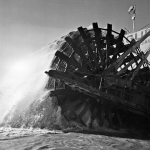
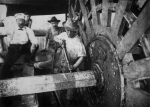
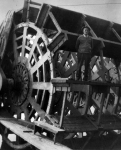




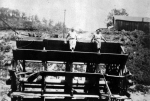

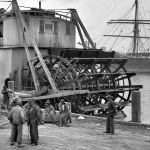

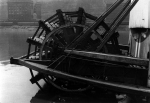




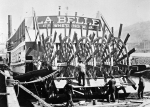
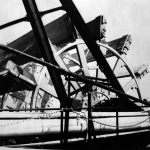
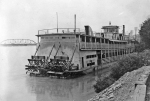
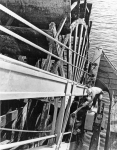
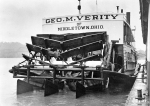


As will all my riverboat research posts, all the images above were collected over the last six years, so I am unsure where they all come from (usually the Library of Congress or from research at my local libraries.) But, they’re all old enough they should all be in the public domain. If something looks or seems amiss, please let me know and I’ll correct it.
In some cases, I did some minor color correction and cropping to keep it all visually consistent. I’m happy to answer any questions folks have about any of these images or riverboats in general. (Sometimes it gives me a good excuse to research something.) You can send me an email or leave a comment below.
More Riverboats
A Riverboat’s Paddlewheel is the latest in my series of posts sharing my research for my future novel Coal Belly. You can check out the other riverboat-related posts with the links below.
A Riverboat’s Passengers
A Riverboat’s Demise
A Riverboat’s Pilothouse
Riverboats at War
A Riverboat’s Roustabouts
A Riverboat’s Menu
Riverboat Interiors
Riverboats & Levees
The Masonic Ironclad
Footnotes and Citations
1 The key word here is “common.” There were a few outliers, of course. Ferries were often centerwheelers, with the paddlewheel built along the vessels beam and the boat constructed around it. There was also the batwing steamers—small vessels with two tiny side-wheels near the stern.
2 Mace, Ellis Clarence, 1862-. River Steamboats And Steamboat Men: a History With Articles And Pictures From My Scrap Book. Cynthiana, Ky.: The Hobson book press, 1944.
3 Hunter, Louis C, and Beatrice Jones Hunter. Steamboats On the Western Rivers: an Economic And Technological History. Cambridge: Harvard University Press, 1949.
 Want to stay in touch with me? Sign up for Dead Drop, my rare and elusive newsletter. Subscribers get news, previews, and notices on my books before anyone else delivered directly to their inbox. I work hard to make sure it’s not spammy and full of interesting and relevant information. SIGN UP TODAY →
Want to stay in touch with me? Sign up for Dead Drop, my rare and elusive newsletter. Subscribers get news, previews, and notices on my books before anyone else delivered directly to their inbox. I work hard to make sure it’s not spammy and full of interesting and relevant information. SIGN UP TODAY →



